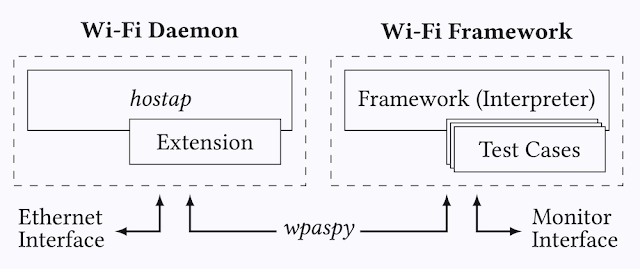We present a framework to more easily perform Wi-Fi experiments. It can be used to create fuzzers, implement new attacks, create proof-of-concepts to test for vulnerabilities, automate experiments, implement test suites, and so on.
The main advantage of the framework is that it allows you to reuse Wi-Fi functionality of Linux to more easily implement attacks and/or tests. For instance, the framework can connect to (protected) Wi-Fi networks for you and can broadcast beacons for you when testing clients. In general, any Wi-Fi functionality of Linux can be reused to more quickly implement attacks/tests. The framework accomplishes this by executing test cases on top of the hostap user space daemon.

Overview of the Wi-Fi Daemon and Framework components.
If you are new to performing Wi-Fi experiments on Linux it is highly recommended to first read the libwifi Linux Tutorial. When you are implementing basic Wi-Fi attacks without the need to reuse Linux functionality, then the framework provides limited advantages and you can instead consider directly implementing attacks in Scapy and optionally use the libwifi library.
Usage
To use the framework:
-
Read the usage tutorial.
Example
Say you want to test whether a client ever encrypts frames using an all-zero key. This can happen during a key reinstallation attack. By using the framework you do not need to reimplement all functionality of an access point, but only need to write the following test case:
Handshake Message 3/4. Action( trigger=Trigger.Connected, action=Action.Function ), # Receive all frames and search for one encrypted with an all-zero key. Action( trigger=Trigger.NoTrigger, action=Action.Receive ), # When we receive such a frame, we can terminate the test. Action( trigger=Trigger.Received, action=Action.Terminate ) ]) def resend(self, station): # Resend 4-Way Handshake Message 3/4. station.wpaspy_command("RESEND_M3 " + station.clientmac ) def receive(self, station, frame): if frame[Dot11].addr2 != station.clientmac or not frame.haslayer(Dot11CCMP): return False # Check if CCMP-encrypted frame can be decrypted using an all-zero key plaintext = decrypt_ccmp(frame.getlayer(Dot11), tk=b"\x00"*16) if plaintext is None: return False # We received a valid plaintext frame! log(STATUS,'Client encrypted a frame with an all-zero key!', color="green") return True">
class ExampleKrackZerokey(Test):
name = "example-krack-zero-key"
kind = Test.Authenticator def __init__(self):
super().__init__([
# Replay 4-Way Handshake Message 3/4.
Action( trigger=Trigger.Connected, action=Action.Function ),
# Receive all frames and search for one encrypted with an all-zero key.
Action( trigger=Trigger.NoTrigger, action=Action.Receive ),
# When we receive such a frame, we can terminate the test.
Action( trigger=Trigger.Received, action=Action.Terminate )
])
def resend(self, station):
# Resend 4-Way Handshake Message 3/4.
station.wpaspy_command("RESEND_M3 " + station.clientmac )
def receive(self, station, frame):
if frame[Dot11].addr2 != station.clientmac or not frame.haslayer(Dot11CCMP):
return False
# Check if CCMP-encrypted frame can be decrypted using an all-zero key
plaintext = decrypt_c cmp(frame.getlayer(Dot11), tk=b"\x00"*16)
if plaintext is None: return False
# We received a valid plaintext frame!
log(STATUS,'Client encrypted a frame with an all-zero key!', color="green")
return True
The above test case will create an access point that clients can connect to. After the client connects, a new 3rd message in the 4-way handshake will be sent to the client. A vulnerable client will then start using an all-zero encryption key, which the test case automatically detects.
You can run the above test case using simulated Wi-Fi radios as follows:
./setup/setup-hwsim.sh 4
source setup/venv/bin/activate
./run.py wlan1 example-krack-zero-key
You can connect to the created access point to test it:
By changing the network configuration this AP can easily be configured to use WPA2 or WPA3 and/or can be configured to use enterprise authentication, without making any changes to the test case that we wrote! Additional benifits of using the framework in this example are:
- No need to manually broadcast beacons
- The authentication and association stage is handled by the framework
- The WPA2 and/or WPA3 handshake is handled by the framework
- Injected packets will be automatically retransmitted by the Linux kernel
- Packets sent towards the AP will be acknowledged
- Sleep mode of the client is automatically handled by the kernel
- ...
See a detailed description of all our examples for more examples.
Publications
This work was published at ACM Conference on Security and Privacy in Wireless and Mobile Networks (WiSec '21):
Works that have used this framework or a similar one:

